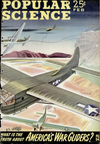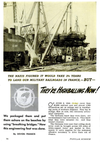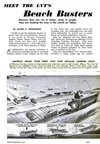Ever since the four-wheeled Sumerian donkey chariot was replaced by the two-wheeled horse-drawn variety, war and technological innovation have gone hand and hand. In no conflict was this more apparent than World War II–arguably the first modern war. As soldiers fought from one end of the globe to the other, scientists developed many of the technologies that underlie not only today’s wars, but our daily lives: nuclear power, radar, jet propulsion and the personal computer.
And for the entire course of the war, Popular Science Magazine documented the enormous scientific advances spurned on by that most awful conflict. So, in honor of the 65th anniversary of the Allied invasion of Nazi-occupied Europe, take a look back at our coverage of D-Day tech from the 1940s when, as always, PopSci envisioned a bold and thrilling future driven by amazing technology. Enjoy.
Will Airborne Police Enforce World Peace?
On the night before June 6th, 1944, the Allies conducted the largest airborne assault in history to support the amphibious landings. Our article from September 1944, “Will Airborne Police Enforce World Peace” looked at some of the gadgetry that made WW2’s wide use of paratroops possible.
Words That Win Battles
The D-Day landings were preceded by a massive psychological warfare attack. Planes dropped leaflets encouraging sabotage and surrender, while others, in an attempt to minimize civilian casualties, warned French citizens about which town would be bombed. We covered PsyOps in June of 1945 in the article “Words That Win Battles.”
General MacArthur Told Me: This is Distinctly an Engineer’s War
Once the Normandy beach was secure, the Allies quickly set about expanding the influx of materiel. To aid in that task, the British Navy built massive modular ports that allowed large ships to offload cargo directly onto the captured beachhead. We took a look at these impressive rigs and others in our May 1945 issue’s “General MacArthur Told Me: This is Distinctly an Engineer’s War.”
What is the Truth About America’s War Gliders?
While parachute units like the 101st Airborne division are the first thing to come to mind when considering the aerial invasion on D-Day, a significant number of troops also arrived in gliders. Importantly, the gliders were able to bring heavier equipment like jeeps and artillery to troops behind the front lines. We devoted our February 1944 cover to wonderous new world of military gilders: “What is the Truth About America’s War Gliders?” (be sure to scroll up for the play-along-at-home fun of “Can You Recognize The Flags of Our Allies”).
Meet the LVT’s Beach Busters
While the term D-Day has come to refer exclusively to the June 6th landings in Normandy, “D-Day” was actually used during the war to describe the first day of any attack. In the Pacific, this meant there were a lot of D-Days, and they were often lead by the amphibious tanks and personnel carriers described in this September 1945 article: Meet the LVT’s Beach Busters






